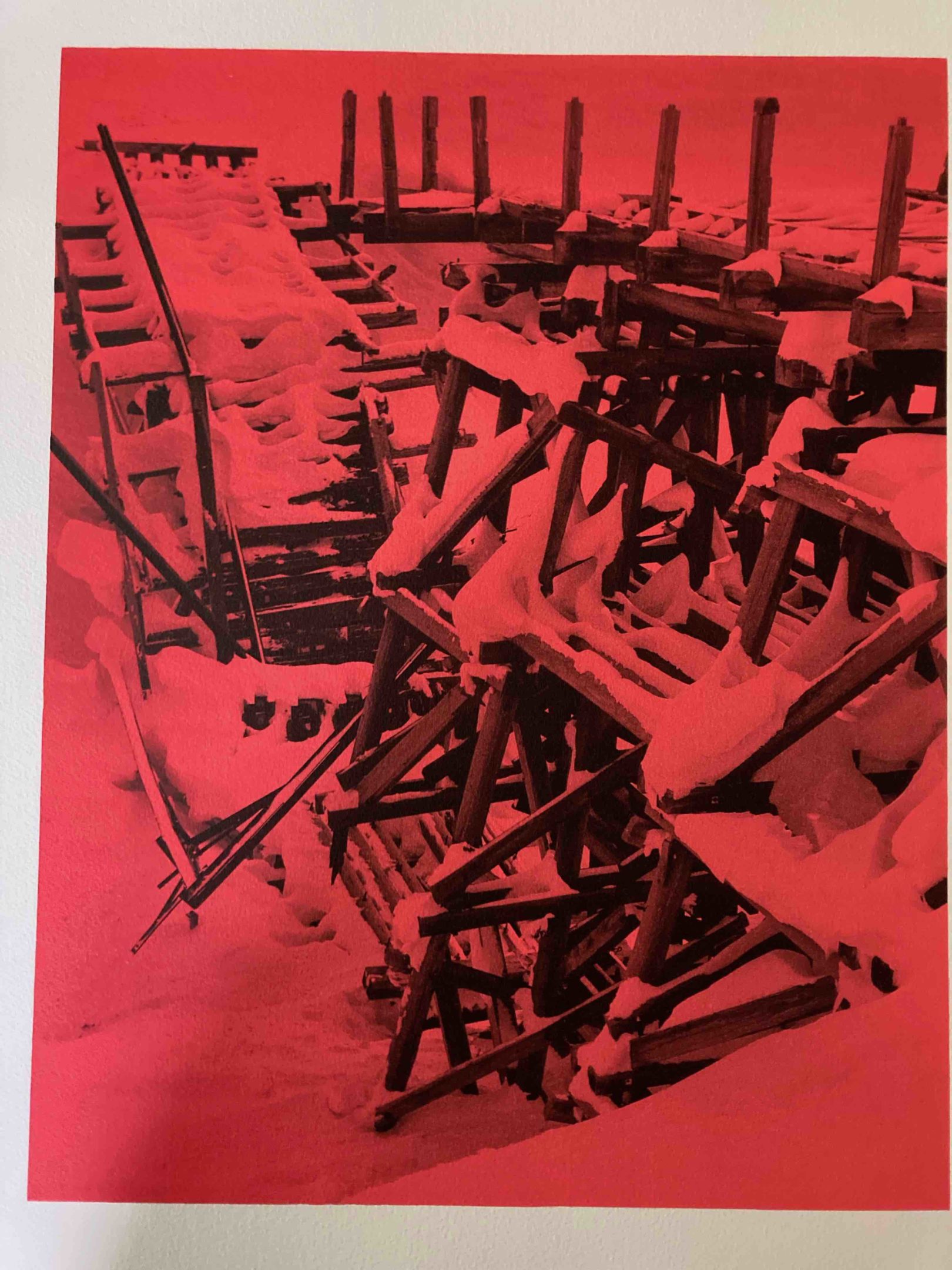Extraction: Art on the Edge of the Abyss
Residencies, projects and exhibition
14 August – 2 October 2021
On exhibition throughout: works by Darren Almond, Andres Chang.
Artists in residence: Kaitlin Ferguson, 9-22 August; Shaun Fraser, 23 Aug – 5 September; Rebecca Faulkner: University of the Arts, London, Art for the Environment Residency: 6-19 September.
Extraction: the context
On-going throughout the summer at GroundWork Gallery are artistic projects which highlight the incredible strains on the environment caused by extraction. The practice of taking resources out of the earth has become one of the biggest problems of the modern world. Everything we live in, walk on and touch daily is somehow extracted from the earth.
The built environment is made from stone extraction; oil, gas, coal for transport and industry comes from drilling, mining and fracking; a whole cocktail of extracted minerals are used in electronics. Mobile phones alone contain copper, nickel, lithium, tungsten, cobalt, tellurium and manganese. The scale of natural resource extraction, even for the so-called environmental technologies like wind turbines and electric cars, is staggering and imposing incredible and increasing stress on the earth.
Art on the Edge of the Abyss
This programme is part of Extraction: Art on the Edge of the Abyss, a United States-based initiative begun in Montana. It is now a global coalition, a multimedia, multi-venue, cross-border art intervention which seeks to provoke societal change by exposing and interrogating the negative social and environmental consequences of industrialised natural resource extraction.
Their aim is to ‘cause a ruckus’ – and we are joining in with them. Join us by coming on Saturdays to the gallery to talk about what we can all do to help – it starts with talking. And then visit the end of summer residency exhibition to talk and plan some more with us.
Works on show throughout the summer
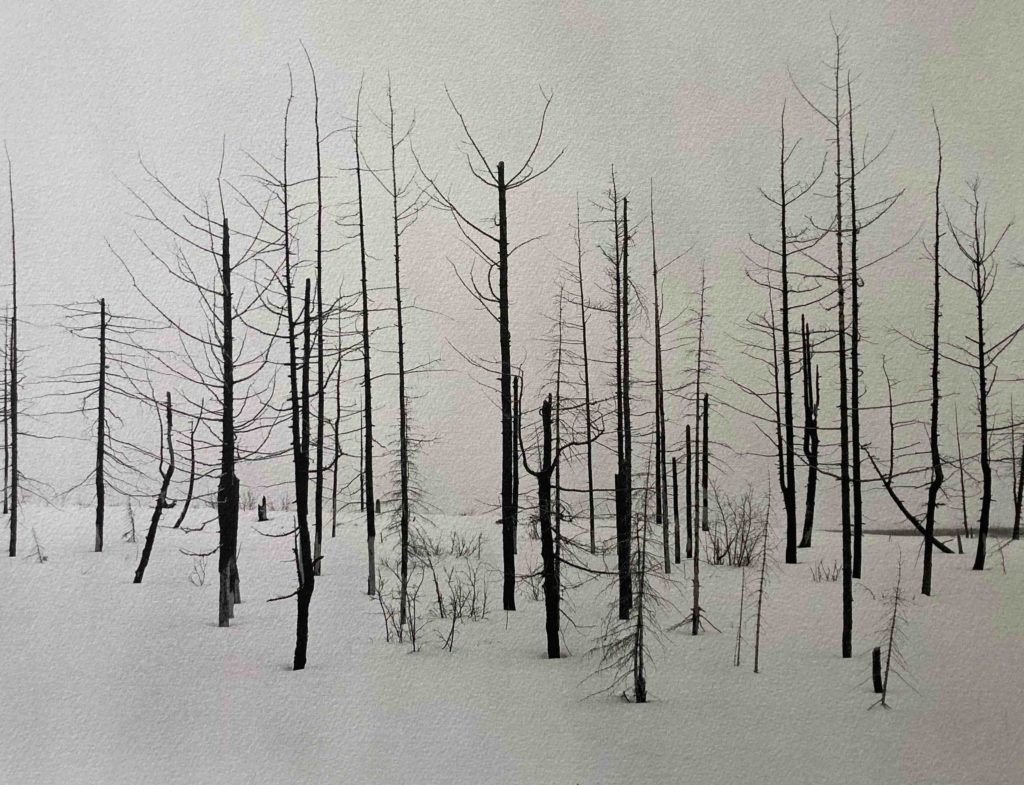
Darren Almond
Norilsk, 2007
Selected images from a portfolio of 17 Photo lithographs printed from stone by Editions Copenhagen
Based on the artist’s extensive research in Siberia, this project devastatingly documents the effects of the nickel-mining industry based around the city of Norilsk.
The background
The Soviet government under Stalin created the infrastructure for nickel mining and other rich mineral sources of Siberia. It was built in effect by slave labour under the old Soviet Gulag. From the mid 1930s, thousands of prisoners, many of them unskilled and unfit were drafted to this extreme northerly arctic region to build railways, roads and infrastructure for the mines. Many, many people died in these cruellest of conditions. Despite numerous setbacks a huge mining industry was created. Simon Ertz documented this story and Darren included an essay in his portfolio from his economic study of forced labour .
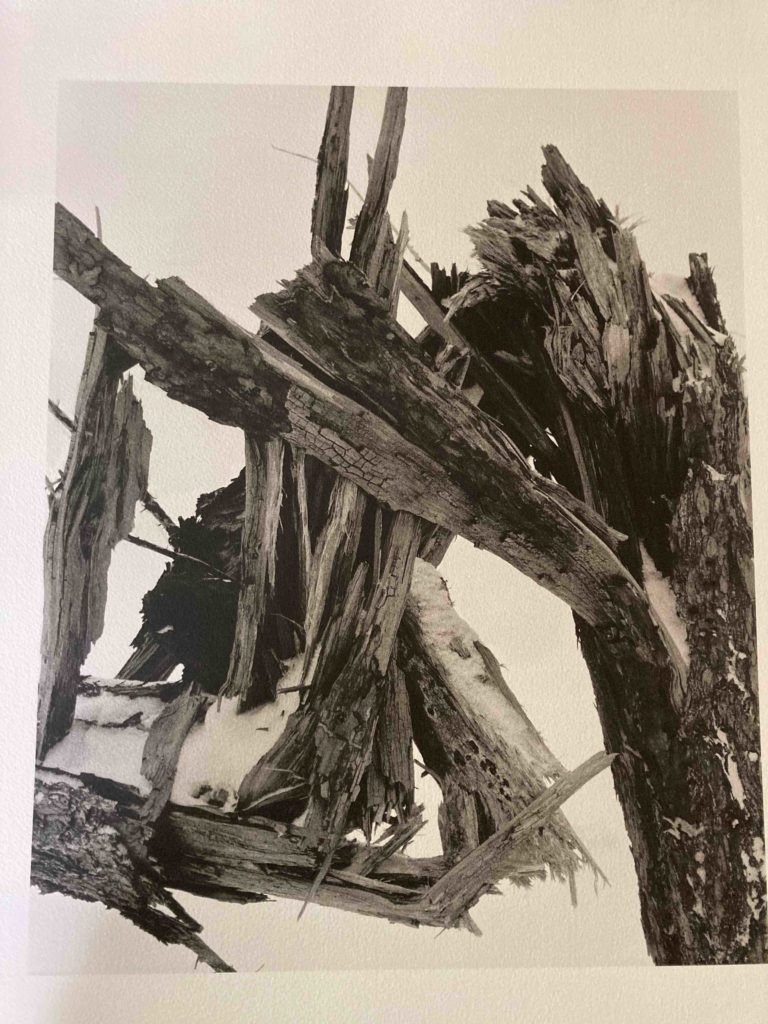
Since 2007, through a number of takeovers and mergers internationally in Australia, Botswana, Finland, South Africa and the United States, Norilsk Nickel is now the world’s largest nickel producer. They also mine palladium, copper, numerous other minerals, and coal. They have a terrible environmental record. Norilsk Nickel emits 1.9% of the world’s sulphur dioxide into the atmosphere. In 2020 the region suffered a disastrous contaminating oil spill which, it is reckoned will take up to 10 years to clear up.
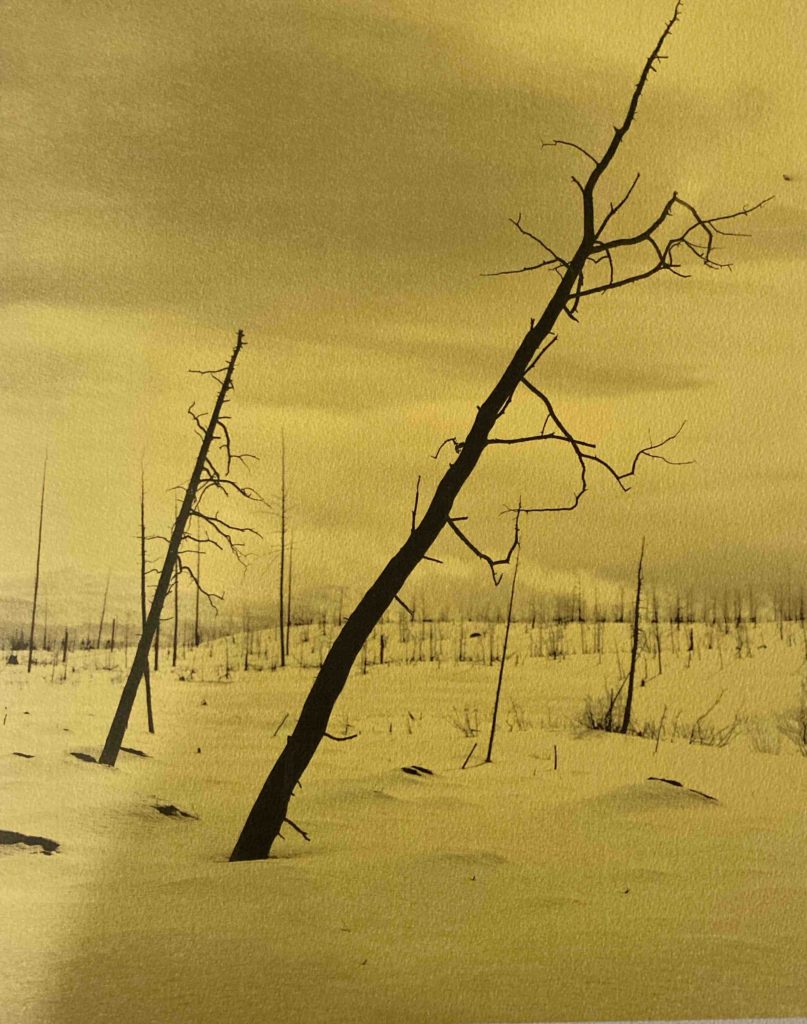
The content
Darren Almond’s work focuses on the environmental impact of such heavy industry on the landscape. The extreme winter weather, temperatures plummeting to minus 50˚ C, meant that Stalin’s original transport system was never completed. Railway bridges, built from massive logs, have fallen. Half a century of acid rain pollution as a result of the mining has killed any forests which remained.
The artist has created a series of utterly poignant images, half of them about the heavily polluted forest, a shadow of its former self, and others about the derelict railway bridge. We see a devastated landscape, sad and full of death.
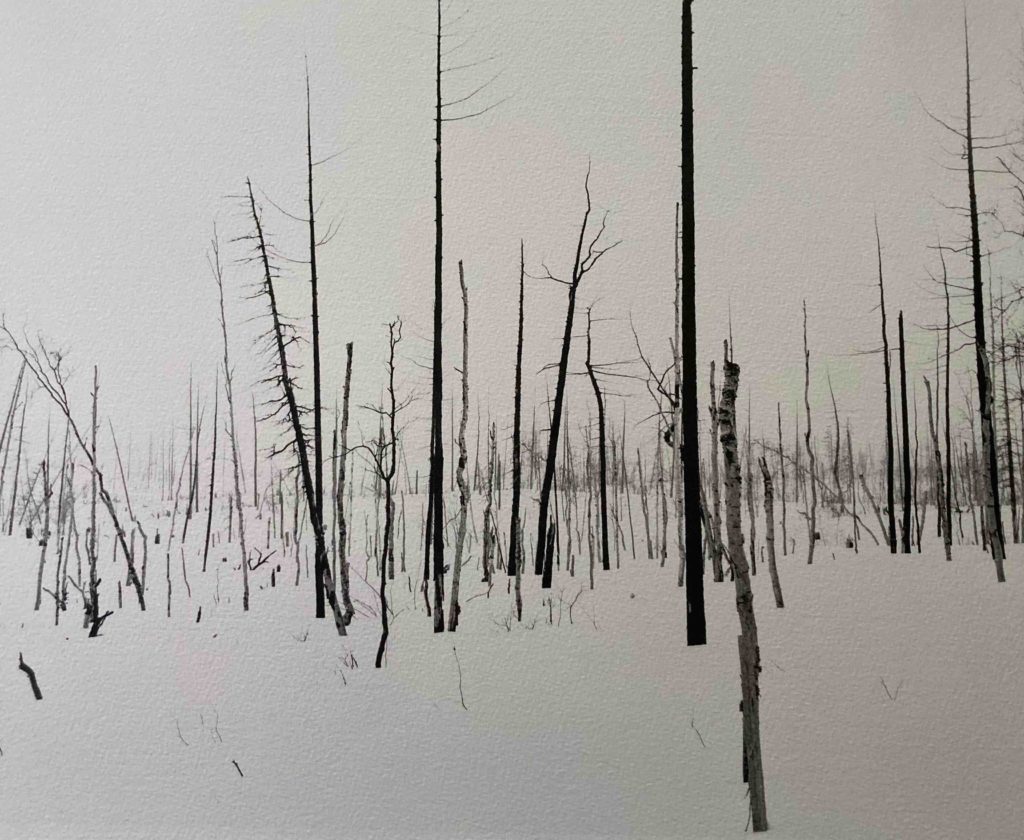
Darren Almond Image no 8 from Norilsk
Darren Almond – about the artist
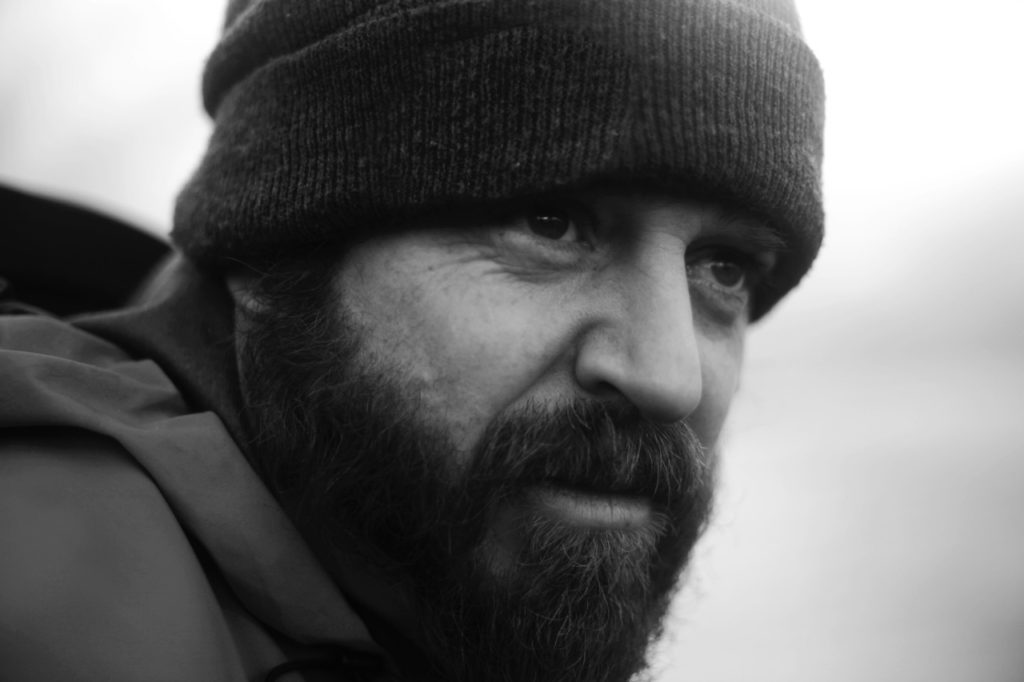
Darren Almond’s diverse practice incorporates film, installation, sculpture and photography. As his representative gallery White Cube says, his formative works were much about meditations on time and duration, personal and historical memory. Since 1998, he has been travelling the world to make a famous series of Fullmoons. These are long exposure photographs giving night-time landscapes an uneasy aura of daylight.
Place and identity connect in his work in very subtle ways. He has increasingly become profoundly interested in the limits of human and environmental endurance, including his own. Since, and including making Norilsk in 2007, he has been exploring extreme conditions of experience or climate. He travels to distant locations and often reveals the unbearable tensions which emerge when people or corporations exploit the world’s resources. However, his work never expresses any of this overtly. It becomes a silent witness to a degraded environment. He becomes a sympathetic observer of human labour under extreme stress.
Andres Chang
The London Convention
Nine drawings made on technical papers from international meetings
Andres Chang has been collecting data for some years about extractivist practices in international corporate and organisational contexts. He has made selections of crucial documents, highlighting the controversial passages. Over these he has made pertinent drawings. This is what he has written as an introduction.
Extractivist governments and corporations have a history of political manipulation. Their deceiptful actions have resulted in millions of deaths and years of wasted time in humanity’s fight against the climate crisis. Nevertheless, the same actors continue to have a dominating influence over energy decision-making, even in political venues dedicated to climate action.
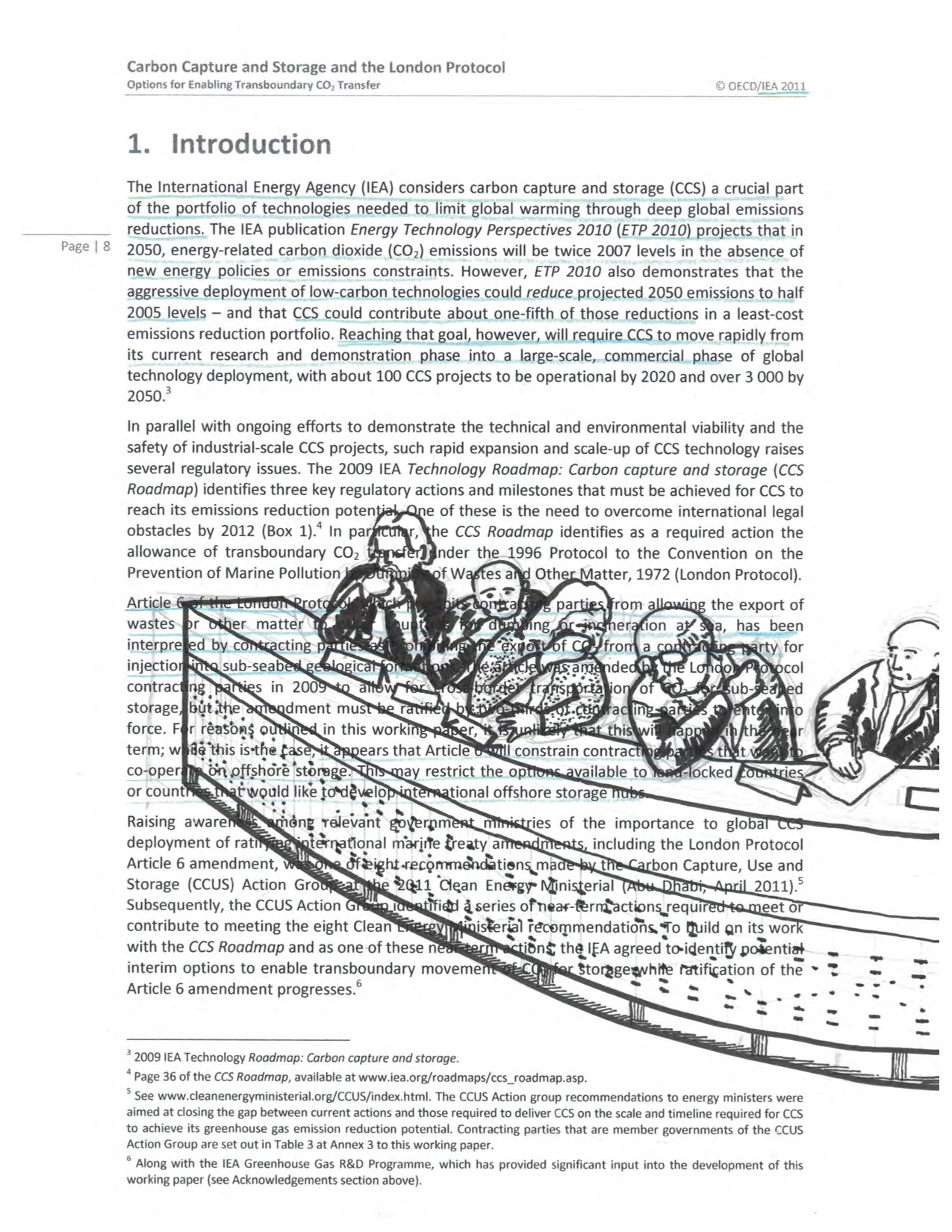
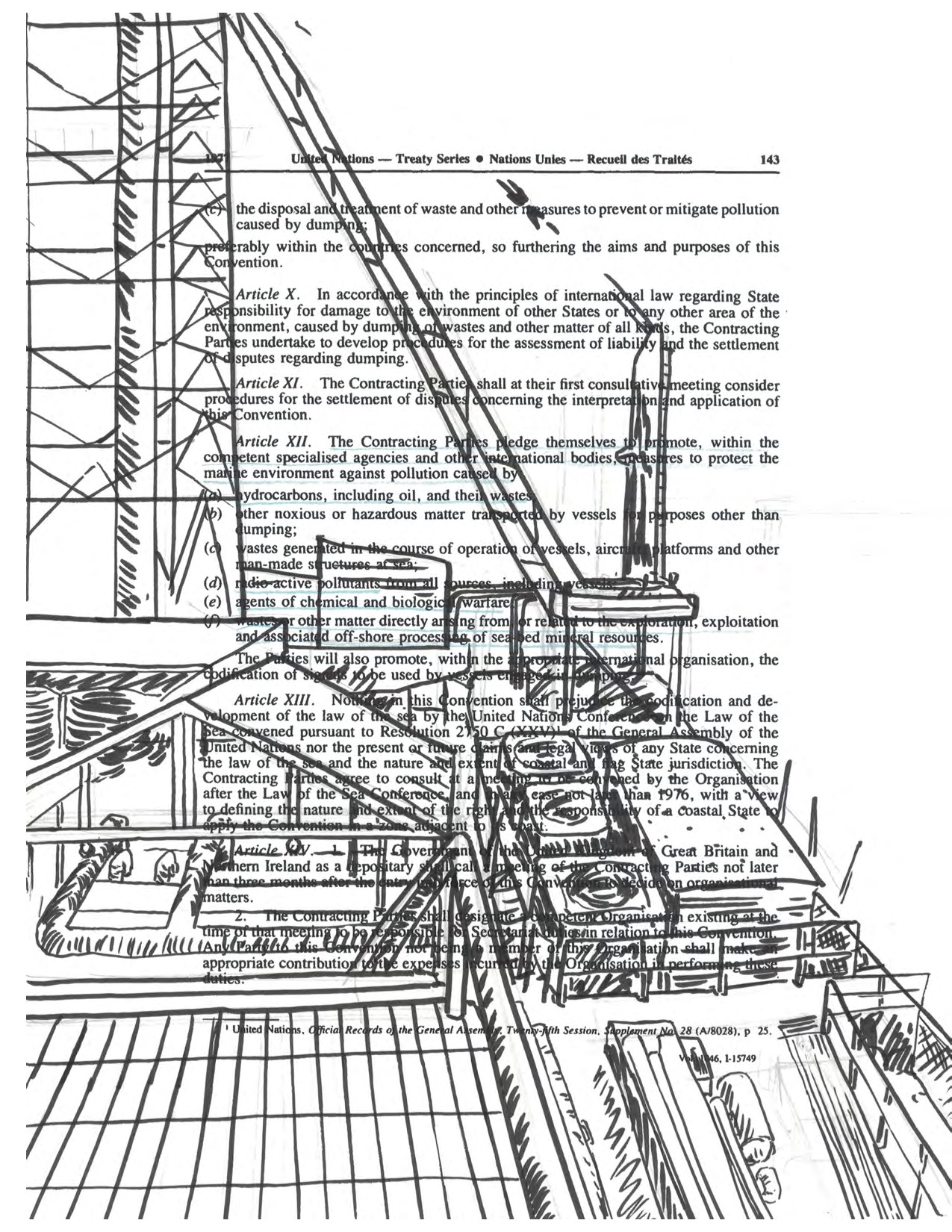
Established in the 1970s to prevent ocean waste dumping, the London Convention has been manipulated since the late 1990s to legitimize controversial “geoengineering” actions like depositing CO2 into the deep ocean or underground by pipeline – otherwise known as Carbon Capture and Storage (CCS). These actions aim to reduce climate change-inducing emissions without disrupting fossil fuel use; but to many activists, they represent nothing more than a smokescreen. Indeed they were also prohibited by the London Convention, until being legalized by amendments that label ocean-based CO2 as an “important interim solution” to climate change. Ironically, many supporters of the amendment were simultaneously investing in fossil fuels, and some were even publicly denying the urgency of climate change.
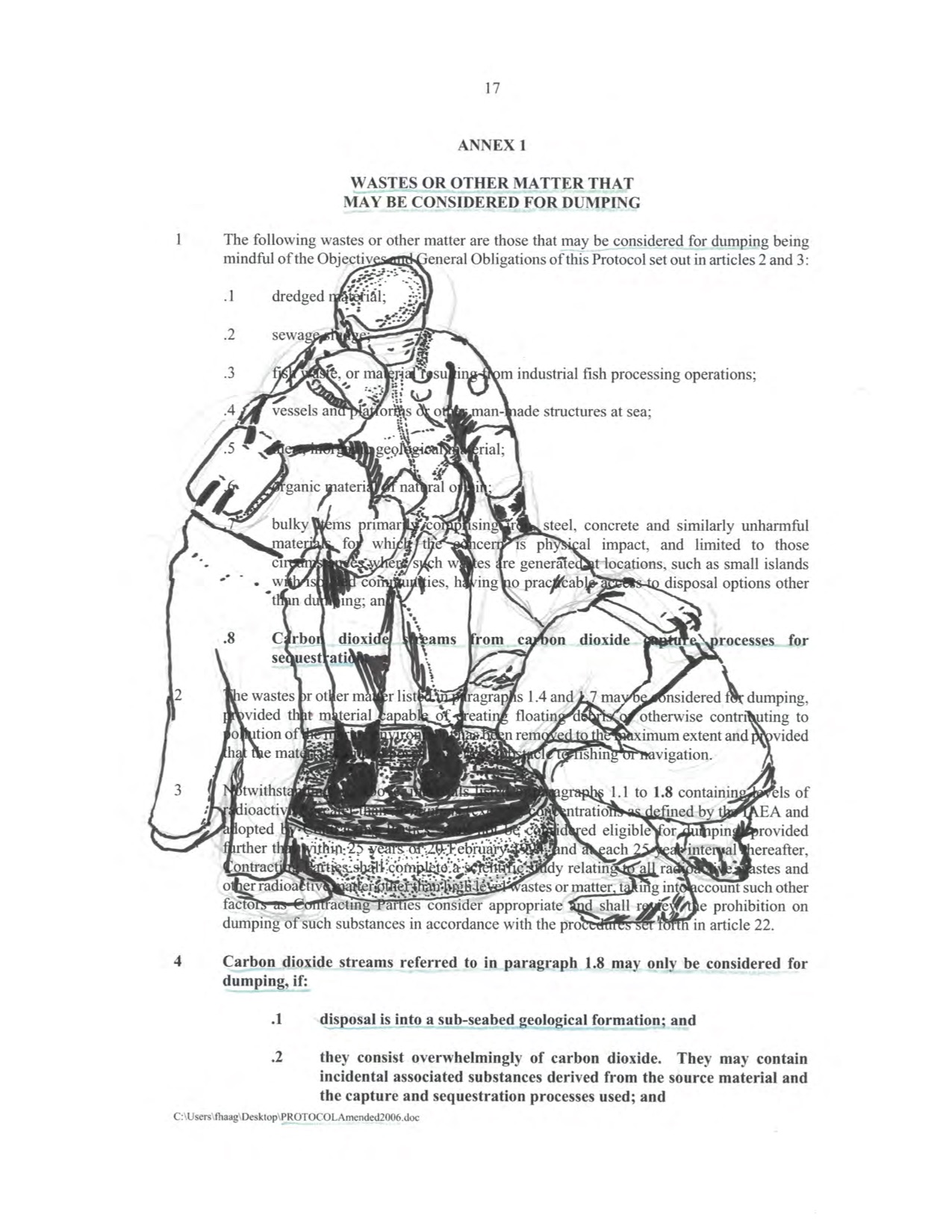
The London Convention Drawings expose a shocking and little-known thread of this story. The project, shown across nine drawings, immerses viewers in a decades-long series of international negotiations affecting maritime law in relation to Carbon Capture and Storage (CCS). The drawings appear in pen and marker on pages from treaty documents, meeting minutes, and associated research studies. As such, they juxtapose the act of “covering up” with the act of investigation.
Andres Chang – about the artist
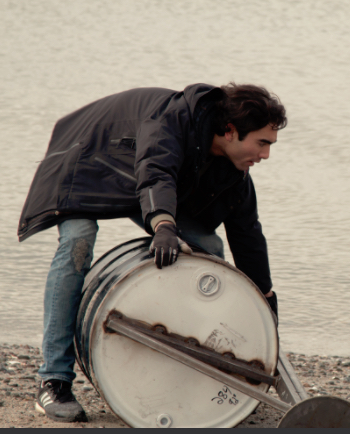
Initially trained as a geophysicist, Andres Chang is an artist and researcher, based in New York, who investigates the emergence of worlds in a time of ecological collapse. By working with a diverse range of media and participatory gestures, he advances a shared approach to the production of environmental knowledge. At their core, Andres’s recent projects question the narrative cohesion of how we understand the past or future: piecing together historical artifacts, familial memories, and scientific research tools in a form of speculative performance.
Artists in Residence: 9 August – 3 October
This is a summer-long programme. Concentrating on issues of stone, gravel and sand extraction around the Norfolk Coast – eg. flint, chalk, silica sand. The overall idea is to draw attention to this extraction industry and to look at its methods and environmental standards. See more information under our Projects pages.
The role of artists is to work in partnership with a multi-disciplinary study group to make aspects of the industry visible. This could be through a variety of means – film, photography, sculpture, painting, drawing, printmaking, textiles, performance, writing …. However, the means used need to be environmentally sensitive and consistent with the overall theme. We will also connect as far as we can with the wider issues of Extraction around the UK & in the US project.
The Norfolk Coast Partnership has supported the residency programme. Norfolk Geodiversity Partnership is acting as consultant advis
Kaitlin Ferguson 9 – 22 August
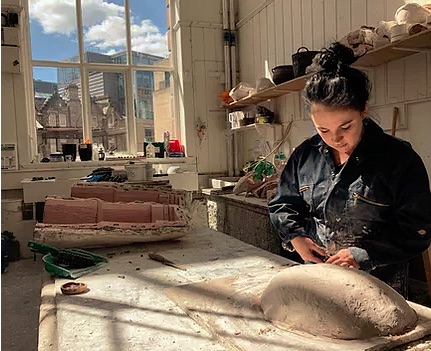
Kaitlin Ferguson is engaging long-term in geological research. This has resulted in drawings and sculptures which she has exhibited in installations in Scotland and Norwich. She is currently working on a Developing Your Creative Practice grant from the Arts Council and is investigating soil structures. This is leading to an exploration of artistic possibilities of diatoms.
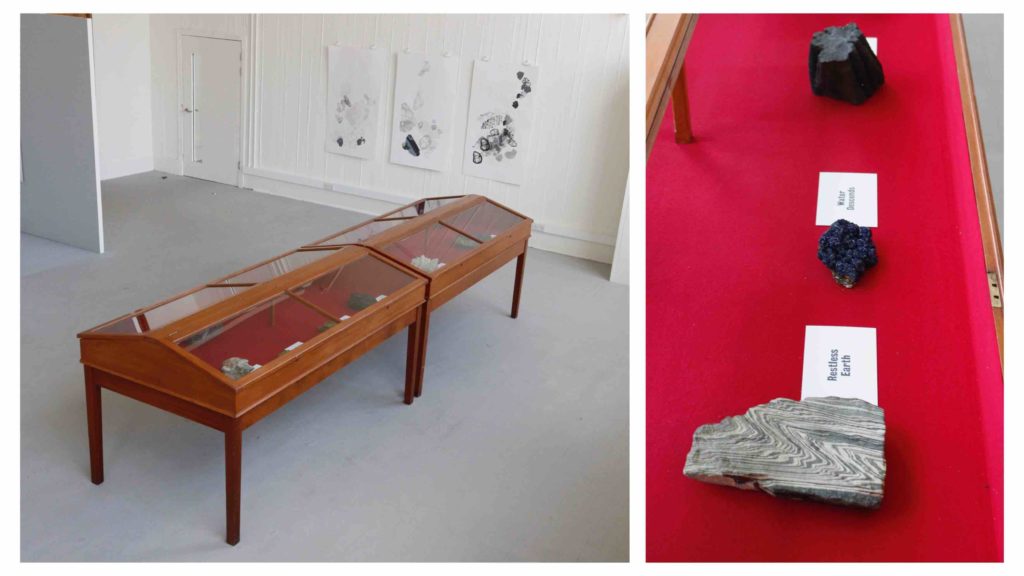
Shaun Fraser 23 Aug – 5 September
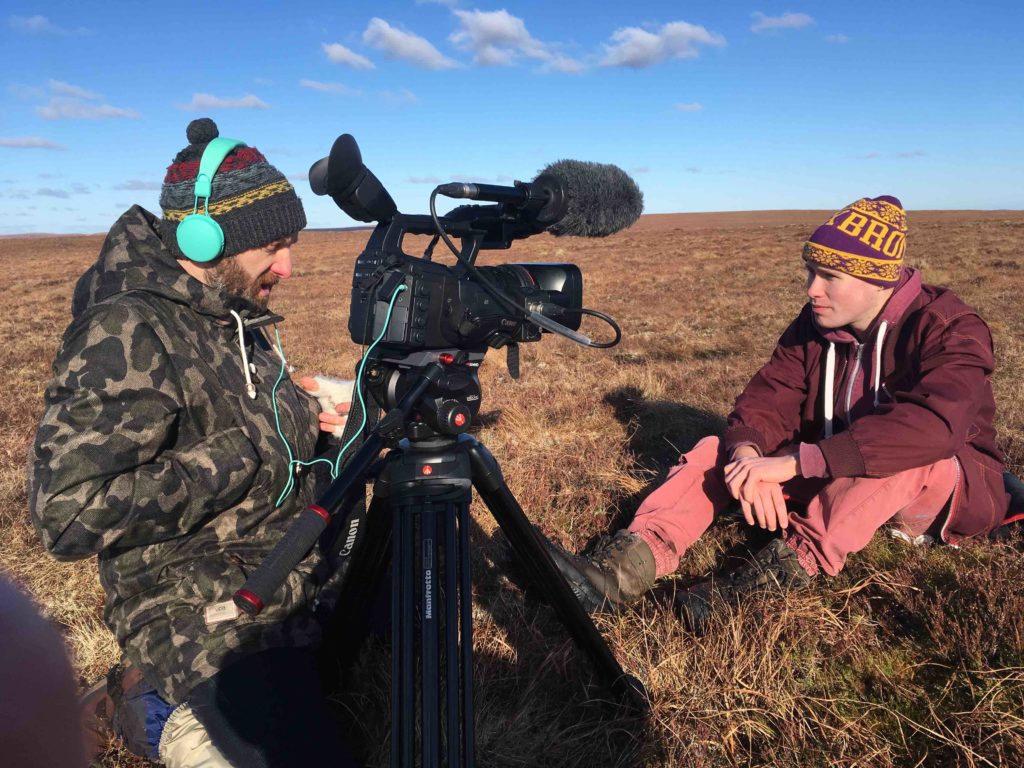
Shaun was an exhibitor at GroundWork in 2019, as one of the lead artists for Theories of the Earth. He trained at the Royal College of Art in the glass department. From there he returned to his native Scottish Highland Isles and has been very much concerned with peat extraction. For the Extraction residency at GroundWork he is likely to be investigating further issues with silica sand, one of the components of glass.
University of the Arts, London: Art for the Environment Residency Programme, 6 – 19 September
Rebecca Faulkner
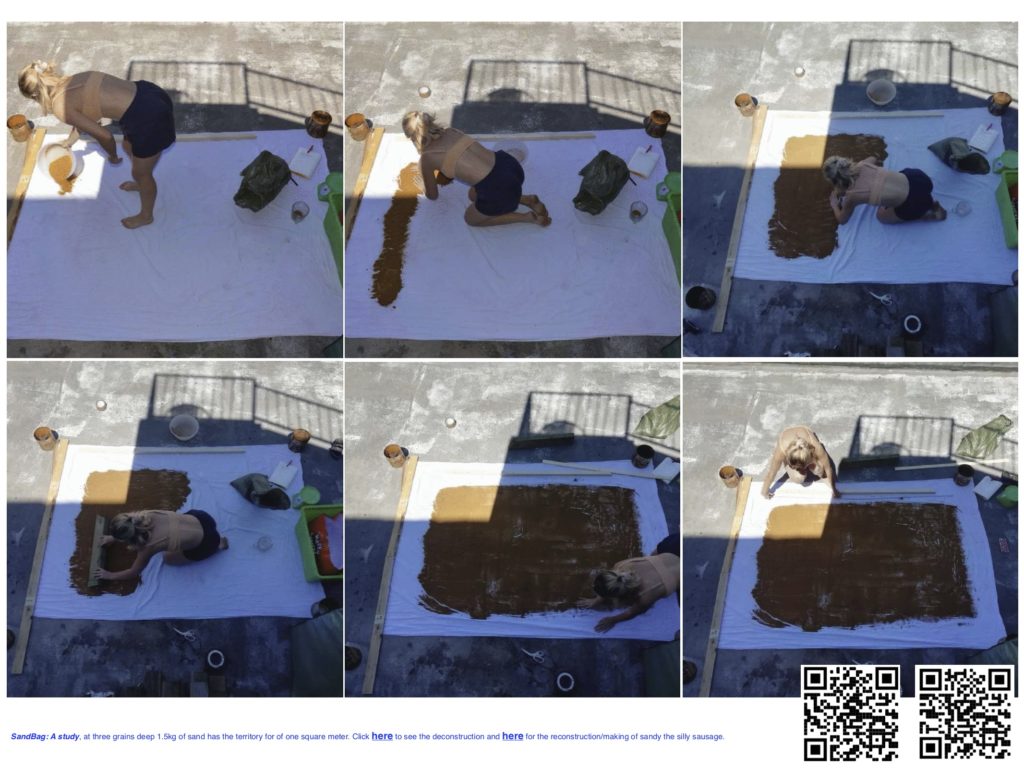
Rebecca Faulkner, MA Architecture student at Central Saint Martins has been selected for the AER Residency at GroundWork Gallery, Norfolk.
An extract from Rebecca Faulkner’s application:
A continued fascination with sand has meant that over the past 18 months I have become
an arenophile understanding how sand is a metaphor for modern-day consumption. The global demand for concrete is growing exponentially. The worldwide price of construction sand has increased by 50% in the last decade. Globally, we now consume 50 billion metric tons of sand (and gravel) every year, amounting to 18kg per person per day, which incidentally is the weight of an optimally filled sandbag. My thesis, Sand and the City, simultaneously advocates for a counter prospect to London’s declining industrial landscape whilst promoting a more socially and environmentally sustainable construction process. It did not manifest through an interest in London’s industrial heritage rather I followed a grain of sand. This work was undertaken within the university setting, but the AER Residency at GroundWork would offer me the opportunity to showcase this publicly.
Rebecca will have the opportunity to work in partnership with a multi-disciplinary study group including Norfolk Geodiversity and Norfolk Coast Partnership (funder), plus Like Minds Norfolk, & GroundWork Gallery team to work on local and/or global issues in connection to extractivism, specially of stones and sands around Norfolk.
My self defined practice sits between the world of performance, movement work and architecture, which gives me a unique perspective for the AER residency. Throughout my time at Central Saint Martins (CSM), my work has made the invisible visible. Whether through choreographing performances that highlight and disrupt legacies and spatial codes of the city or immersive spoken word pieces about the destructive social and environmental consequences of global sand mining.
Rebecca Faulkner
The Art for the Environment International Artist Residency Programme
Set up by Professor Lucy Orta UAL Chair of Art for the Environment – Centre for Sustainable Fashion in 2015, The Art for the Environment International Artist Residency Programme (AER) provides UAL graduates with the exceptional opportunity to apply for short residencies at one of our internationally renowned host institutions, to explore concerns that define the 21st century – biodiversity, environmental sustainability, social economy, and human rights.
GroundWork Gallery Extraction residencies 2021 is organized in association with EXTRACTION: Art on the Edge of the Abyss, a multimedia, multi-venue, cross-border art intervention which seeks to provoke societal change by exposing and interrogating the negative social and environmental consequences of industrialized natural resource extraction.
Extractivism – What can art do? What have artists done?
The whole ethos of art is anti-extractivist. It gives more than it takes. Art is about making things significant and precious.
Art often shows the first way to change. Sometimes through shock-tactics – showing the horrors and realities. Sometimes showing the beauties we are losing.
Above all, art makes visible the invisible. It forces us to see new realities in new ways. Art both comes from an experience, making it more concrete, and creates a new experience for us, the viewer.
Artists make things we have to talk about now. GroundWork’s Extraction exhibition programme and projects will extend over two summers and be accompanied by discussion and conference programmes. Contact us if you wish to be involved. Sign up to the newsletter for regular further info.

